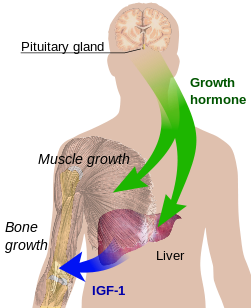Growth in stature, determined by its various factors, results from the lengthening of bones via cellular divisions chiefly regulated by somatotropin (human growth hormone (hGH)) secreted by the anterior pituitary gland. Somatotropin also stimulates the release of another growth inducing hormone Insulin-like growth factor 1 (IGF-1) mainly by the liver. Both hormones operate on most tissues of the body, have many other functions, and continue to be secreted throughout life; with peak levels coinciding with peak growth velocity, and gradually subsiding with age after adolescence. The bulk of secretion occurs in bursts (especially for adolescents) with the largest during sleep.
The majority of linear growth occurs as growth of cartilage at the epiphysis (ends) of the long bones which gradually ossify to form hard bone. The legs compose approximately half of adult human height, and leg length is a somewhat sexually dimorphic trait. Some of this growth occurs after the growth spurt of the long bones has ceased or slowed. The majority of growth during growth spurts is of the long bones. Additionally, the variation in height between populations and across time is largely due to changes in leg length. The remainder of height consists of the cranium. Height is sexually dimorphic and statistically it is more or less normally distributed, but with heavy tails.
Search This Blog
Monday, September 19, 2011
Subscribe to:
Post Comments (Atom)
Blog Archive
-
▼
2011
(1292)
-
▼
September
(160)
- lack of sun exposure cause premature aging
- Barefoot Sun Walking Heals the Body and Prevents D...
- 한거(閑居)
- 경상도인의 외국 이주가 많은 이유
- 로마는 바그다드까지 먹었다
- 5년간 근친강간 2000건, 짐승의 낙원 한국
- 가야는 임라였다.
- 중국 '아시아, 美軍뒤에 숨지마라' 비판
- '세계 좀비 지도'
- Fastest Cars In The World: Top 10 List 2011-2012
- 중세 영국이 프랑스어를 왕실 공용어로 사용한건 프랑스인이 왕실인이어서 그런것이다.
- wrong use of the term latino, hispanic, spanish in...
- Roman Empire
- Greek Empire
- SUN GAZING PHENOMENA, BROUGHT BACK
- Macedonia Beauty Contest
- ‘살아 있는 전설’ 메시, 194호골로 바르사 역대 최다골 2위 등극
- fastest white man Christophe Lemaitre
- Liposuction may help your heart
- 뒷주머니에 지갑 넣고 앉는 아저씨, 다리 꼬고 앉는 아가씨 … 안됩니다
- 고구려 백제 신라의 성씨 비교
- 육식이 만병의 근원이라는 오해
- 백제가 망하지 않았다면 엄청난 힘을 가졌을껏
- 한일관계의 진정한 뿌리는 바로 신라VS백제다
- 계백은 일본의 감독관이었다
- 에미시와 에조는 다른집단이라더군
- 세계 양대저질민족 영국과 독일
- 몽고반점은 북빵기마민족이라든가 몽골족과 관계없다.
- 이거 알면 백프로 경상도인
- 인터넷에 함부러 글섰다간 취업못한다.
- 프랑스는 최강대국이었다
- 세계 장기 독재자 순위
- 살인의 달인, 살인의 귀재. 백년간 세계 살인마 순위
- 1789년 이전 세계의 위대한 군주 131명
- 일본인은 아이누의 후손이다.
- 흑인들이 못하는 운동
- 사실 전반적 근육량이나 완력자체는 흑인보단 백인들이 더좋다
- 난징학살이라고 주장하는 짤을 분석해보면 무지 또는 왜곡
- 백제의 유물
- 신라의 유물
- Japan may soon lose its top longevity ranking
- Yellow eyelid blobs hint at hidden heart disease
- 비염·성기능 장애·생리불순 … 알고 보니 나쁜 자세 탓
- 재즈
- 경상도에서 족보를 사기 힘든 이유?
- 쌀은 밀에 비해 단백질이 몹시 부족함
- 신라 해적
- '금연하면 성적 능력 향상'
- Smokers don't make better lovers: study
- 통일 신라의 사리함 조각
- 부산 사투리 주차뿔라
- 레몬에이드와 개구리 생존의 과학적 관계?
- Stunning sun photographs taken by amateur
- “회 먹다가 잘못하면”…사람 잡는 비브리오 패혈증
- 모유 수유, 바로 알고 하세요
- 일본 기업 한국 기업 기술원조 내용
- 리오넬 메시, 네스타에 굴욕…바르샤-AC밀란 2:2 무승부
- Nesta dominate messi
- 일본이 한국에 베푼 원조
- a TRICK you can use different accounts between you...
- 도시 사람이 시골 사람보다 건강하다
- 중동 물담배 1시간 흡연이 담배 200개비 흡연과 맞먹는다
- 커피로 차가 움직인다고?…자동차 관련 이색기록들
- 스페인 카탈루냐, ‘투우’ 빨간 천 접는다
- 광개토태왕의 백제정벌로 한반도백제인들이 대거 일본열도로 이주하였다.
- 애벌레를 잡아먹으려다 외려 잡아 먹힌 두꺼비
- 인류의 진화 과정
- “빛보다 빠른 물질 발견”
- 성도착증 ‘자기색정사’
- 청장년 급사 증후군
- “자상한 아빠, 남성호르몬 수치 낮아”
- Faster than light particles found, claim scientists
- 전주중심의 전북은 충청도와 역사적 인류적 비슷한점이 더 많다
- 전주는 사실 충청권이지
- 아직도 스페어 타이어 달고 다니세요?
- 문화유전자 밈(meme) 동물에게도 있다
- 술이 암을 일으킨다.."정말이었네"(동양인은 서양인에 비해 술이 더 해롭다)
- 포르노의 폐해
- "가습기 살균제 영유아 5명 사망"
- `불타는 무지개` 신비로운 모습 포착
- NASA: Satellite pieces to hit Earth in a week
- Culture Heritage Pompeii villa opens in Paris...
- 남을 감동시킬만한 취미정도는 개발하라
- '뇌를 늙게 만드는 물질, 혈액 속에 있다'
- 삼국통일은 일제시대때 만들어진 용어
- 고구려는 당나라보다 국력이 컸으나 내부분열로 망했다
- Process of growth(pituitary gland)
- Germany or Austria have more african admixture tha...
- 재즈 [jazz]
- 美 "쌀의 기원지는 9000년전 중국 양쯔강" 결론
- 과일 맛을 잡아라! 당도 높이는 법
- '수수' 고지혈증 등 성인병 예방에 탁월
- 브로콜리, 이제 ‘고추냉이’와 함께 드세요
- 서부경남 사투리강좌
- 지루한 미식축구
- The Chemical Sunscreen Health Disaster
- 칠지도 명문에는 백제가 상국이고, 왜국이 속국으로 나와 있다.
- Messi got fat
- 음경 만곡증 부르는 페이로니씨병
- 미 - 녹색지대
-
▼
September
(160)

No comments:
Post a Comment